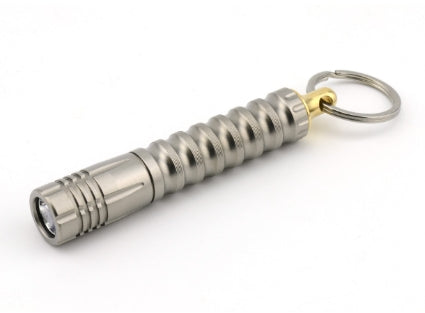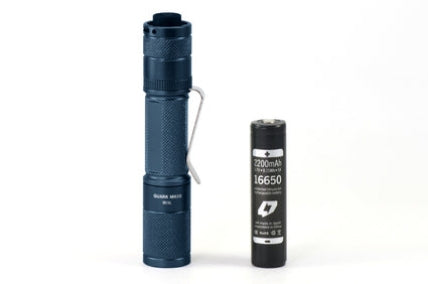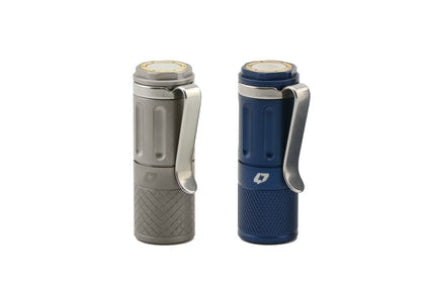This short episode is in response to a handful of reports (some recent) of 2-cell lithium flashlights exploding. One instance in November resulted in a fatality – the user had his flashlight in his mouth while working under the hood of his car. (For the record: these were NOT Prometheus Lights or Foursevens flashlights.)
In the interest of safety, we put together this PSA to help you all understand what is likely causing this to happen and, most importantly, how to prevent it. Any 2-cell lithium light has the potential to pose the same danger. Be informed.
If you have experience with this or have anything to add to the conversation, please feel free to jump in and comment below.
Here are those incidences referenced in the show:







Always use lithium batteries with built in protection circuitry and buy yourself one of these testers. Test every CR123 battery before you use it in your flashlight. This relatively inexpensive tester helps to avoid mixing older batteries with newer ones. Mine works great! Hope this helps keep everyone a little safer.
https://www.ztsinc.com/minimbt.html
Hi guys?, and gals;
I find that ‘most’ retailers ‘do’ mention in the manual to “NOT” mix and match batteries in this particular flashlight. You all mentioned that they did not but that’s a mistake people, most all of them ‘warn’ you to not do this with ‘ANY’ batteries in flashlights. J.F.Y.I. God Bless and have a great day.
Cal Talbot
Hi,
This is incredibly important safety information you’ve shared. I have grandkids, and as you know many toys run off batteries. Now after listening to this podcast I can protect them from any potential danger. I will be passing this warning on…
Thank you!
Very helpful discussion.
How bout a session on battery charging tips and safety?
Thanks much, Jeff
Very helpful discussion.
How bout a session on battery charging tips and safety?
Thanks much, Jeff
Thanks Jason.
Great podcast. Lots of good info in it.
Glad you did that for us.
Will you have in stock any Maelstrom REGEN MMR-X batteries in the future?
Thanks again.
John
JohnT737
A safe alternative to 2x CR123A batteries is a Protected, Rechargeable 16650 battery. I run them in my FourSevens lights as well as my Surefire. They are the same length (65mm) as an 18650, but have a 16mm diameter rather than 18mm diameter to fit into the smaller body. The single cell is the same size as 2 CR123’s. Valuable podcast. Thank You.
Ethan
One more thing, holding the flashlight in your mouth needs to stop. Put it under your shirt collar, please. It is much easier and it rivals a headlamp for usability. I used this method for almost 40 years as I mentioned in my previous email. This method works best with a button down shirt with a collar and a larger size light, not the smallest ones.
It is very sad that these accident happen, but the blame has to be at least partially shared by some of the users. I read a lot of information on the various flashlight forums and it seems that people tend to purchase the cheapest available. That is not a good idea with lithium ion cells, since there are so many cheap and inferior cells on the market. I’m sure that some people mix and match cells and who knows if they even own a voltmeter and know how or when to use one. I didn’t know anything about electricity until I got a job with an electric utility company in 1967, retired in 2006. I really should have kept a journal and written a book. I’d probably have a best seller by now. My advice is to buy single cell lights only, the newest LED’s produce an amazing amount of light. If 2 batteries of any type are mounted in a flashlight side by side it does not mean that they are always wired in a parallel electrical circuit. My Olight SR51 with 2-18650’s measured 7.70 volts indicating that the batteries are in series. My Sup Beam K40 measures 11.93 volts with 3-18650 batteries, also in series . My only other multi 18650 cell is a Fenix TK35 and the 2- 18650’s are wired in parallel. For multi cell flashlights, buy a set of identical high quality protected cells, charge them together in a high quality charger and check the voltage of each cell. Make sure they are within 0.1 volt of each other.
Hi, do alkaline batteries in series pose the same threat or is it just lithium or nickel metal hydride batteries?
Thanks
GREAT podcast, guys, timely & critical info re: blowing up
ones head by using inherently unsafe flashlight batteries
by mouth (which, daresay, we’ve ALL done) So be warned…
Thanks for the heads-up, Jason… Cheers ANYWAY, LJD…
Thank you for that I have kept flashlights in my mouth while working on cars my whole life. Now I won’t take that risk using two cell rechargeable.
According to inventors of the lithium ion battery, they were exclusively designed per a DARPA program for use in a “non-atmospheric” environment, i.e., outer space. The inherent design and chemistry will always be unstable when used in other than non-atmospheric environments, i.e., on Earth.
A Japanese battery manufacturer somehow obtained the design, and because Li-Ion batteries don’t tend toward memory problems like Ni-Cads, etc., (thus reducing their efficacy), manufacture of Li-Ion batteries proceeded with limited safeguards to maintain stability, and labeled as “{Protected”. Still, they are not designed for atmospheric use, and they will always be unstable to some extent when so used in that environment.
Newer and exceedingly better batteries have subsequently been invented, but being under the aegis of DARPA, it will be some long while before they hit the market here.